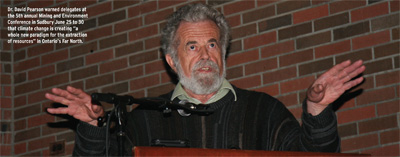 The challenging terrain of Northern Ontario’s Hudson Bay Lowlands and the effects of climate change may force mining operators to develop new strategies for the disposal of tailings, warns Laurentian University Earth Sciences professor Dr. David Pearson.
The challenging terrain of Northern Ontario’s Hudson Bay Lowlands and the effects of climate change may force mining operators to develop new strategies for the disposal of tailings, warns Laurentian University Earth Sciences professor Dr. David Pearson.
Speaking at the 5th annual Mining and Environment International Conference in Sudbury, June 25 to 30, Pearson said, “the challenges are such that even my geological colleagues are telling me that we need a whole new paradigm for the extraction of resources in the Far North because the natural environment will change so much.“Even if the climate stays stable, the challenges are enormous because of it being a wetland,” said Pearson, who is a member of an expert climate change panel advising the Ontario government. “It’s not like the country we’re used to in mid-Northern Ontario. This is not Sudbury or Timmins. It’s like another planet.”The McFaulds Lake area in the Hudson Bay Lowlands, where Cliffs Natural Resources hopes to begin mining a massive chromite deposit by 2015, is 300 kilometres from the coast, but not even 200 metres above sea level, he noted.
Wet
“Not only is it flat, but the major characteristic of the terrain is that it’s also very wet,” said Pearson. “ If you go to the Ring of Fire and look for rocks, I understand there are exactly two outcrops in an area of 20 square kilometres. What you see when you get there is water and peat-saturated wetlands – the third largest wetlands on the planet. This is difficult terrain to even begin to think about how to securely impound tailings.”
Planning for tailings disposal in the Ring of Fire needs to account for the slow dispersal of water that will drain off any surface tailings, as well as the cumulative effects of dispersal in an environment that Pearson describes as a wetlands saturated sponge.
Ice cover
Another concern is that the duration of the ice cover season on Hudson Bay is decreasing by about one day per year, reducing the cooling capability of the refrigerator that has kept Ontario’s Far North cool until now, he said.
By the middle of the century, temperatures in the Hudson Bay Lowlands are projected to be five to seven degrees warmer, and will have as much of an effect on the landscape of the Hudson Bay Lowlands as the warming since the last Ice Age, said Pearson.
“These are very, very large temperature increases – some of the largest projected anywhere on the planet for the middle of the century, and it’s only 40 years away.”
The open pit chromite mine that Cliffs Natural Resources is planning to develop will have a 100-year mine life, “so halfway through the life of the mine, the climate they are working in will change significantly,” said Pearson. “This will certainly affect the security and stability of the tailings disposed of, particularly from the sulphide mines and the waste rock from the chromite mine.”
In addition to higher temperatures, we can also expect more precipitation, he warned.
Permafrost
Another issue to consider is the melting of the permafrost in the Far North.
“The permafrost acts like a layer of cellophane over the top of the ground in which organic peat is slowly decaying,” said Pearson. “It acts as a cap on the potential release of the methane gas produced by that slow decay. The methane gas is a greenhouse gas and as the ice melts, one of the results we can expect and should be concerned about is the release of methane into the atmosphere.”
Tailings management presents enough of a challenge for mining companies operating at much lower latitudes and in much more benign environments, he said. In Elliot Lake, for example, uranium mine operators had to conform to a 10,000-year security requirement for radioactive tailings, while in Sudbury and other locations in Northern Ontario, mining companies have to contend with the risk of acid mine drainage from sulphide ores.
“Tailings are a real challenge,” said Pearson. “They’re sensitive chemically and they’re sensitive physically. They’re fine-grained, they’re easily eroded and they’re easily wind-blown as well. We have 50 years of experience and research with the stabilization of tailings in our own backyard (Sudbury) on very easy terrain – orders of magnitude easier than managing tailings in the Far North.”
Pearson didn’t propose any solutions for tailings disposal in the Hudson Bay Lowlands, but noted that Noront Resources has undertaken to dispose of its tailings underground, and warned that rather than contemplate surface tailings disposal in the Far North, mining companies may have to think about transporting them out of the region.
“If you’re going to build a railroad to bring out the valuable part, maybe you need to face the fact that you can’t leave the tailings there either,” he said.


